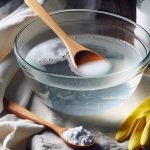Do you ever wonder if using rubbing alcohol on your clothes will cause any damage? The answer is yes, it can.
Rubbing alcohol is a common household item used for cleaning and disinfecting surfaces, but it can also cause discoloration and bleaching on clothes. Rubbing alcohol contains ethanol, which is a powerful solvent and can break down certain materials.
This means that when rubbing alcohol comes into contact with your clothes, it can cause the dye to fade or even remove it completely. While rubbing alcohol can be useful for removing stains, it’s important to use it with caution to avoid damaging your clothes.
Table of Contents
What is Rubbing Alcohol?
You’ve probably used rubbing alcohol before, but did you know it could potentially ruin your clothes? Rubbing alcohol is a common household item that can be used for various purposes, such as disinfecting surfaces and cleaning wounds. It contains a high percentage of isopropyl alcohol, which makes it a powerful solvent that can dissolve oils, grease, and dirt.
When used on clothes, rubbing alcohol can cause discoloration, fading, and even bleaching. This is because isopropyl alcohol reacts with dyes and pigments in fabrics, breaking them down and causing the colors to fade. It can also cause the fabric to weaken and become brittle, leading to holes and tears.
To avoid damaging your clothes with rubbing alcohol, it’s important to use it carefully and only on surfaces that can handle it. If you must use it on clothes, make sure to dilute it with water and test it on a small, inconspicuous area first. If you notice any discoloration or damage, stop using it immediately and try a different method.
How Does Rubbing Alcohol Affect Clothes?
When using rubbing alcohol, it’s important to be aware of how it may impact the appearance of your wardrobe. Rubbing alcohol is a powerful solvent, meaning it can break down and dissolve certain substances.
When applied to clothing, rubbing alcohol can cause the fabric to fade or discolor, especially if it’s a darker color or made of a delicate material like silk or wool. In addition to causing discoloration, rubbing alcohol can also leave behind a residue on clothing.
This residue can be difficult to remove and may require multiple washings or special treatments to fully eliminate. It’s important to avoid getting rubbing alcohol on your clothes whenever possible, but if a spill does occur, be sure to treat the affected area as soon as possible to minimize any damage.
Overall, while rubbing alcohol can be a useful household item for cleaning and disinfecting, it’s best to avoid using it on your clothes. If you must use rubbing alcohol for a specific task, be sure to wear protective clothing and work in a well-ventilated area to minimize the risk of any damage to your wardrobe.
Can Rubbing Alcohol Bleach Clothes?
When it comes to using rubbing alcohol on clothes, there are several factors that can affect the outcome. These factors include the type of fabric, the concentration of the alcohol, and the length of time the alcohol is in contact with the fabric.
Case studies have shown that rubbing alcohol can bleach clothes, especially if it is used in high concentrations or left on for too long.
However, expert opinions vary on the effectiveness and safety of using rubbing alcohol as a stain remover on clothes.
Factors that Affect the Outcome
Factors such as the type of fabric, concentration of alcohol, and duration of exposure can greatly impact the outcome of using rubbing alcohol on clothes. Rubbing alcohol can cause discoloration and fading on delicate fabrics like silk, rayon, and wool, but may not have any effect on fabrics like cotton, polyester, and nylon.
To better understand how rubbing alcohol will affect your clothes, consider the following factors:
-
Fabric Type: The type of fabric will determine how the rubbing alcohol interacts with it. Delicate fabrics are more prone to damage and discoloration.
-
Concentration of Alcohol: The concentration of rubbing alcohol can also impact its effects on clothes. The higher the concentration, the more likely it is to cause damage or discoloration.
-
Duration of Exposure: How long the rubbing alcohol sits on the fabric can also play a role in the outcome. The longer it sits, the more time it has to cause damage.
-
Color of the Fabric: The color of the fabric can also impact the outcome. Lighter colors may be more prone to discoloration and fading, while darker colors may not show any noticeable effect.
Case Studies
Take a look at some real-life examples where people have accidentally damaged their clothing by using rubbing alcohol.
In one case, a woman spilled rubbing alcohol on her favorite black dress while trying to remove a stain. To her dismay, the alcohol caused the dye in the dress to fade, leaving behind a noticeable white stain. She tried washing the dress multiple times, but the damage was irreversible. She had to throw away the dress she loved so much.
Another case involves a man who accidentally spilled rubbing alcohol on his white shirt while cleaning a wound. He thought nothing of it and continued wearing the shirt. However, after a few hours, he noticed that the area where the alcohol had spilled had turned yellowish. He tried washing the shirt, but the stain remained. He had to discard the shirt as it was ruined beyond repair.
These examples show that rubbing alcohol can indeed damage clothes, and it’s important to be careful while using it around fabrics.
Expert Opinions
Now that you’ve read about some real-world experiences with rubbing alcohol and clothes, it’s time to turn to the experts. Many people are curious about whether rubbing alcohol will bleach clothes, and it’s a question that professionals in the cleaning industry are well-equipped to answer.
According to cleaning experts, rubbing alcohol can indeed bleach clothes if it’s not used properly. The key is to dilute the alcohol before using it on fabrics, as pure rubbing alcohol can be too harsh and may cause discoloration. In general, a solution of one part rubbing alcohol to two parts water is a safe and effective ratio to use for cleaning clothes.
However, it’s important to test the solution on a small, inconspicuous area of the garment first to ensure that it doesn’t cause any damage or discoloration.
How to Remove Rubbing Alcohol Stains from Clothes
First, you’ll want to soak the affected area in cold water to help remove the rubbing alcohol stain from your clothes. This will prevent the stain from setting in and making it harder to remove. Make sure to use cold water instead of hot water because hot water can set the stain and make it permanent.
Once you’ve soaked the garment, you can try using a stain remover or laundry detergent to remove the remaining stain. Here are some steps you can follow to help remove the rubbing alcohol stain from your clothes:
- Apply a small amount of stain remover or laundry detergent directly onto the stain.
- Gently rub the stain with your fingers or a soft-bristled brush.
- Let the stain remover or laundry detergent sit on the stain for at least 5 minutes before washing the garment as usual.
If the stain persists after washing, repeat the process or try using a stronger stain remover.
With a little patience and effort, you can remove rubbing alcohol stains from your clothes and restore them to their original condition.
Tips for Preventing Rubbing Alcohol Stains
If you want to prevent rubbing alcohol stains, there are a few tips you should keep in mind. First, make sure you handle rubbing alcohol safely by wearing protective gloves and working in a well-ventilated area.
Additionally, you should store rubbing alcohol properly to avoid spills or leaks.
Lastly, consider using alternative products, such as vinegar or hydrogen peroxide, which are less likely to cause stains.
Safe Handling
To handle rubbing alcohol safely, you’ll want to wear gloves and work in a well-ventilated area. Rubbing alcohol is a harsh chemical that can irritate your skin, eyes, and respiratory system. Therefore, it’s important to take precautions to protect yourself from harm. Here are some tips for safe handling:
First, wear gloves to prevent the alcohol from getting on your skin. Nitrile gloves are a good choice because they are resistant to chemicals and punctures. Second, work in a well-ventilated area to avoid inhaling the fumes. Open windows or use a fan to circulate the air. Lastly, keep rubbing alcohol away from heat sources, sparks, and flames as it is flammable. Follow these steps to ensure safe handling of rubbing alcohol.
| What to do | Why it’s important | How to do it |
|---|---|---|
| Wear gloves | Prevents skin irritation and contact with the chemical | Use nitrile gloves |
| Work in a well-ventilated area | Avoid inhaling fumes | Open windows or use a fan |
| Keep away from heat sources, sparks, and flames | Prevents fires | Store away from heat sources |
By following these safety measures, you can prevent accidents and protect yourself while using rubbing alcohol. Keep in mind that rubbing alcohol should only be used for its intended purposes and should not be ingested or used on your skin excessively. Stay safe and handle rubbing alcohol with care.
Proper Storage
Now that we’ve covered safe handling of rubbing alcohol, let’s talk about proper storage. It’s important to store rubbing alcohol in a cool, dry place away from any sources of heat or flame.
Here are some tips to ensure that your rubbing alcohol stays in good condition:
- Keep it away from direct sunlight, as UV rays can break down the active ingredients in rubbing alcohol over time.
- Store it in a container with a tight-fitting lid to prevent evaporation and contamination.
By following these storage guidelines, you can ensure that your rubbing alcohol remains effective and safe to use. Proper storage can also help prevent accidental spills or fires, which can be dangerous and costly.
Remember, taking care of your rubbing alcohol is just as important as using it safely.
Alternative Products
Looking for other options? There are plenty of alternative products available that can work just as well as rubbing alcohol for sanitizing surfaces.
One option is hydrogen peroxide, which is a powerful disinfectant that can kill bacteria, viruses, and other germs. It’s also safe for most surfaces, including fabrics, and won’t bleach or discolor them like rubbing alcohol can. Simply mix equal parts hydrogen peroxide and water in a spray bottle, then spray the solution onto surfaces and let it sit for a few minutes before wiping it away with a clean cloth.
Another alternative to rubbing alcohol is white vinegar. Like hydrogen peroxide, white vinegar is a natural disinfectant that can kill germs and bacteria on surfaces. It’s also safe for most fabrics and won’t cause any discoloration or damage. To use white vinegar, simply mix equal parts water and white vinegar in a spray bottle, then spray the solution onto surfaces and let it sit for a few minutes before wiping it away with a clean cloth. Not only will this solution sanitize surfaces, but it will also leave them smelling fresh and clean.
What to Do If Your Clothes Get Bleached by Rubbing Alcohol
Uh-oh, your favorite shirt’s been ruined by rubbing alcohol bleaching it. Here’s what you can do to fix it:
First, don’t panic! There are a few things you can try to salvage your clothing item and restore it to its former glory.
The first thing you can do is try to remove the bleach stain by using a color-safe bleach or hydrogen peroxide. Dilute the bleach or hydrogen peroxide with water and apply it to the affected area. Let it sit for a few minutes, then rinse it off with cold water.
This method may not completely remove the bleach stain, but it can lighten it and make it less noticeable. If the bleach stain is still visible, you can try dyeing the clothing item.
Choose a dye that matches the color of the garment and follow the instructions on the package. This method can be a bit risky, as dyeing may not always produce the desired result. However, it can be a great option for clothing items where the bleach stain is small and not too noticeable.
Remember, if all else fails, you can always turn the clothing item into a DIY project. Embellish it with patches, embroidery, or fabric paint to create a unique and personalized garment. Don’t let a bleach stain ruin your favorite clothing item – get creative and turn it into something even better!
- What Types of Clothing Are Nylon? - April 19, 2024
- What Are the 5 Types of Nylon? - April 19, 2024
- What Are the Characteristics of Nylon Fabric? - April 19, 2024







